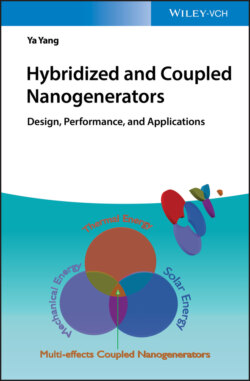Читать книгу Hybridized and Coupled Nanogenerators - Ya Yang - Страница 40
2.3.4.1 Self‐Powered Printer
ОглавлениеThe printer is a common office equipment, and has been used widely in offices, schools, and supermarkets. However, immobility and high energy consumption are two main drawbacks of current printers. Therefore, Chen et al. developed a self‐powered printer system, which consists of a simple handheld printer and a transparent TENG. The handheld system was assembled with a syringe and an acrylic holder [51]. The TENG could harvest wind energy, and then generate electrical energy to power the printer.
To provide unidirectional voltages to power the printer, a rectifier was used to adjust the primary output voltages generated by the TENG. Figure 2.14a shows the working mechanism of the self‐powered printer system. The wind‐driven TENG system can generate a DC voltage of about 130 V under a wind speed of 20 m/s, which could form an electric field between the nozzle and the copper sheet. The droplet surface could accumulate positive charges under this condition. The droplet was exposed to gravity and the downward electric field force, and could fall toward the copper sheet when the downward collective force was larger than the van der Waals force between the nozzle and the color ink droplet. The separating process of the droplet was illustrated in Figure 2.14b–d. Figure 2.14e shows that the letters of "TENG" were successfully color printed by the self‐powered printer system. In addition, this system can be used to fabricate a flexible conductive path comprised by printing Ag nanowire suspension, as shown in Figure 2.14f. A light‐emitting diode fixed on the path can be lightened by applying a 2.5 V DC voltage. Figure 2.14g shows a handheld printing system, which can be powered by human mouth‐blown air. In this condition, the value of output voltage was about 55 V. The handheld printing system can be used to print discrete points by harvesting mouth‐blown wind energy, as shown in Figure 2.14h.
Figure 2.14 The working principle and a photograph of the fabricated self‐powered printer. (a) The schematic diagram of the printer working principle. (b–d) Images of the separating process of the ink droplet. (e) The conductive circuit was printed by the printer and Ag nanowire suspension. (f) The letters were printed by the printer. (g) A photograph of the handheld printing system. (h) The curve printed by harvesting mouth‐blown wind energy.
Source: Reproduced with permission from Chen et al. [51]. Copyright 2018, Elsevier.
